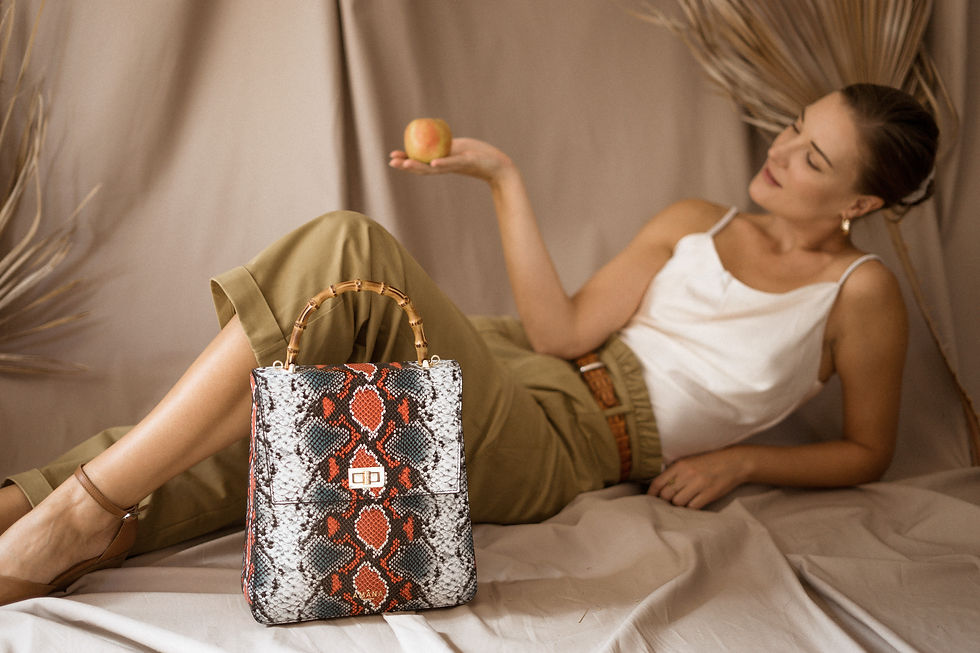The True Cost of Namibian Leather Handbags.
- Amâna

- Apr 28, 2021
- 4 min read
Updated: May 5, 2021
8 March 2019

Leon Engelbrecht working on one of his tote bags in his shop, Leon Engelbrecht Design in Windhoek.
Photograph by Shawn van Eeden and Creative Lab.
My immense love for the leather handbag industry started when I was still a fashion design student doing my post-graduate in Exotic Leather Accessory Design in South Africa where I had the opportunity to work with one of the best exotic leather goods manufacturers in Southern Africa - I absolutely fell in love with factory life.
(pic of me at the factory)
I was always a bit more drawn to the technical side of design and soon found myself in the position of a product developer. This changed design for me completely, not knowing how beneficial it would be in the long run.
Quickly moving from being a mere product developer to setting up and managing a factory in Namibia, presented me with numerous unexpected challenges - challenges that are still questionable and that we are still facing today.
After the first product launch of people hastily complained about the price of the bag without questioning the time, labor or materials going in to the product. Well, I’m about to break it down for you, so that next time you’re presented with a beautiful leather handbag that you think twice about the price before pushing it aside for a cheaper version.
Being situated in Namibia means we have access to all that amazing leather being produced here at the best rate possible, true? The complete opposite in fact.

According to the Ministry of Industrialization, Trade and SME Development (MITSMED), in 2004, 83% of the wet blue hides (wet blue is the first stage of tanning, where it is not yet dried, dyed and finished) were exported, leaving the Namibian market with 17% of the remaining skins.
It is not shocking that the majority of skins are shipped off to Europe and China to be finished, utilized and capitalized, but what is unreasonable is that the local market is left with the lower grade skins and sold at nearly the same export price.
Sourcing leather in Namibia was nearly impossible to get consistent quality and uniform colors from local suppliers. This leaves us with the question of why is it so difficult for Namibian manufacturers and designers to gain from the natural sources that our own country is producing? At the end it is more economical to import leather and receive the consistent quality required for producing larger quantities. There must be a way we can change this to support local tanneries and simultaneously benefit from the deal.
My experience with training local people to produce something special and unique with their hands has made me realize that there is immense value to the products that cannot necessarily be monetized.
Training more than 13 people in the beginning felt extremely overwhelming and frustrating for me, as I never before had to work with so many different ethnicities and personalities. This challenge is something I miss now every day. The love and attention is transferred in to every panel, every corner and every stitch they produce on a handbag.
Apart from the lovely description of the staff and their attention to detail, there are times of stress when the orders are coming in. Keeping up with the demand is not easy, as it can take up to four days to make one handbag. Yes, you heard me, FOUR days on one bag!
I challenge you to think about your 8-5 job, take your rate and see what the labor alone for four days would be. Too much for a handbag? That’s right. And that is excluding the cost of materials, the mark-up and the running costs of a factory.
(pic)
There is a lot more that goes in to the price of a handbag than just the cost of the materials and the labor.
Shipping and duties for one is almost exactly the same price as the cost of a handbag. Shipping from Namibia to anywhere in the world is extremely expensive and it just pushes the price over the line of affordable to a price not justifying the product.
There are a lot of companies in Namibia catching on to the idea of e-commerce, but even with special rates for start-up companies the cost of shipping a bag to Europe ends up +- N$ 2 500.00. That is more than most of us will spend on a handbag alone. Surely there must be a cheaper alternative to exporting handbags and bringing the money back in to our country.
The Namibian consumers must stop comparing prices of Namibian made products to those found in the general retail stores as it is completely different processes and different environments in which the product is developed.
I truly hope that we as Namibian companies can stand together and support each other to create more international sales and to get the Namibian products out in the world. If not support on a large scale, I hope Namibians change their perspective of the price and value of these products to a more positive note.



Comments